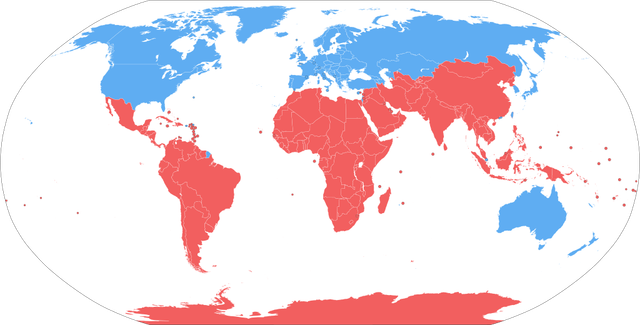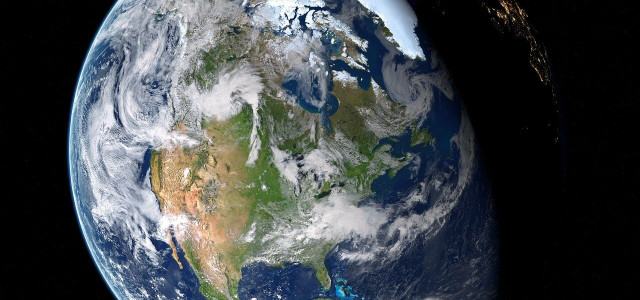The terms ‘Global South’ and ‘Global North’ can be convoluted and misleading. While they aren’t based purely on geography, the definitions vary across the context and time period.
The divide between the so-called Global North and Global South is based on the Brandt Line, a physical line dividing the world into “north” and “south”. Unlike the equator, it is not based on latitude, but rather on economic status of the countries it divides. This line was proposed in the 1980s in order to demonstrate how the divide between rich and poor countries sat quite reliably between the north and south of the Earth. The only exceptions were Australia and New Zealand. Essentially, the terms served to replace the more dated concept of ‘first world’ and ‘third world’ nations — which could be said to imply a value judgment. The term ‘Global South’ is often used interchangeably with ‘underdeveloped’ or ‘developing’ countries.

(Foto: Kingj123, Public domain, via Wikimedia Commons)
The concept of a Global South and Global North has changed considerably in the last decades, as the world’s economies and conditions have developed and changed. The geographical line is not so simple anymore. It’s also important to note that the terms ‘Global South’ and ‘Global North’ can be defined in different ways. For these reasons, the terms have been criticized. By some definitions, for instance, Malaysia, Argentina and Botswana no longer fit into the ‘Global South’ label. Official organizations therefore prefer to classify states using more measurable, easily defined terms. The World Bank, for example, classifies countries by the gross national income: a country can be low, medium or high income. National development of a state can also be measured by GDP or Human Development Index.
What Are the Global South and Global North? 3 Definitions
There are currently three general definitions used to measure the Global North and South.
- The first is based on economic development of states. More recently, this definition changed to reflect which nations are negatively impacted by modern capitalist globalization.
- The second definition refers to the Global South as a body of nations with the shared experience of domination and exploitation under global capitalism.
- The third definition breaks down the geography of the Global North and South, and argues that there also is great wealth inequality within the borders of nations themselves. Antonio Gramsci, a famous Italian Marxist, argues, for example, that northern Italian capitalists have colonized the south of the same country. This definition has contributed to the concern that these terms are dated.
As inequality grows, there are countries which are difficult to pinpoint as belonging to the Global North or South under any of these definitions. India, for example, has seen economic growth leading to the rise of the middle class and a rich elite. However, the nation still has some of the highest rates of slums and extreme poverty in the world.
Global South versus Global North: What’s the Conflict?



(Foto: CC0 / Pixabay / alex_madred)
The Global North and South are most often defined based on a variety of measurements including their resources, education, health, living conditions, economy, industry, trade, markets, government, international relations and conflicts. The inequalities between the Global North and South have manifested at the hands of the Global North.
Put simply, the inequality experienced disproportionately in the Global South is rooted in the colonialism and imperialism historically inflicted by the Global North. The Global South has been robbed of its natural resources and labor rights for centuries, creating an unequal playing field from the start. Today, there continues to be an unequal exchange between rich and poor countries, with inequality worsening due to unfair trade. Research shows that rich countries continue to import materials, energy, land and labor from poor nations at exploitative prices, boosting their own economies only. In fact, in 2018 alone, unequal exchange accounted for 2.2 trillion Dollars. This is fifteen times more than the amount required to end extreme poverty. Between 1960 and 2018, the Global North drained 62 trillion Dollars from the Global South, with researchers concluding that “rich countries continue to rely on imperial forms of appropriation to sustain their high levels of income and consumption.”
Not only does this unequal trade contribute to the prevention of development in the Global South, but it is unsustainable. The rates of consumption in the Global North are greatly contributing to climate change, while the countries of the Global South have the smaller carbon footprint. According to the Global Climate Risk Index 2020 by the Germanwatch institute, the five countries or states most affected by climate change in the 21st century are all part of the Global South: Puerto Rico, Haiti, Pakistan, Myanmar and the Philippines.
Read more:
- Techlash: A Democratic Move or a Threat to Sustainable Growth?
- Forest Conservation: Definition & 7 Impactful Methods
- Abortion Access in the US: An Uncertain Future
Do you like this post?






